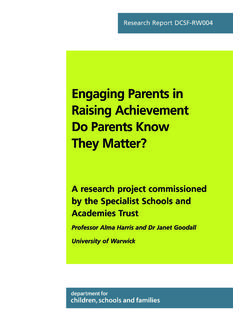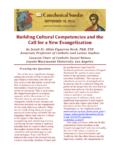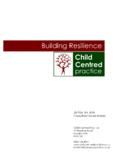Transcription of Building a Culture of Participation - UCL Institute of ...
1 5147-DfES-BuildPart-H'book 28/11/03 14:06 Page fci Building a Culture of Participation Involving children and young people in policy, service planning, delivery and evaluation HANDBOOK. Perpetua Kirby Claire Lanyon Kathleen Cronin &. Ruth Sinclair 5147-DfES-BuildPart-H'book 28/11/03 14:07 Page iii This Handbook was researched and written by the National Children's Bureau (NCB) and PK Research Consultancy (PKRC). For further information about the research contact Ruth Sinclair (Director of Research, NCB) or Perpetua Kirby (Director, PKRC). National Children's Bureau 8 Wakely Street Lodon EC1V 7QE. Tel: +44 (0)20 7843 6000. Fax: +44 (0)20 7278 9512. PK Research Consultancy Ltd 12 Sussex Road Hove BN3 2WD. Tel: +44 (0)1273 728191. The views expressed in this Handbook are the authors' and do not necessarily reflect those of the Department for Education and Skills. ISBN: 0-9546695-1-7. 5147-DfES-BuildPart-H'book 28/11/03 14:07 Page 1.
2 Contents Introduction 3. Summary of Key Messages 7. Vision for Change: Increased Child and Youth Participation 9. The Policy Shift: Involving Children and Young People 9. Practical Benefits to Services 10. Citizenship and Social Inclusion 12. Personal Development 13. Participation and the Organisation 15. How Integral is Participation to your Organisation? 15. Why do you Want to Involve Children and Young People? 19. Developing a Culture of Participation within Organisations 23. Becoming a Learning Organisation 23. Developing Cultures of Participation 25. Participation in Practice 41. Developing Positive Relationships with Children and Young People 41. Fostering Other Relationships 52. Choosing How to Involve Children and Young People 55. Contents 1. 5147-DfES-BuildPart-H'book 28/11/03 14:07 Page 2. 2 Building a Culture of Participation Handbook 5147-DfES-BuildPart-H'book 28/11/03 14:07 Page 3.
3 Introduction Increasingly acceptance of the principle of children's involvement is being turned into practice through a variety of Participation activities across a range of organisations. But some have difficulty in translating their commitment into practice that is meaningful for children and young people, which is effective in bringing about change and which becomes embedded within the organisational ethos. This Handbook draws on the findings of a research study that explored the experiences of 29 organisations in seeking to listen to young people and to take action on what they said. The research points to this being most likely to succeed where organisations had worked to sustain and embed their Participation activity. This Handbook and the accompanying research report Building a Culture of Participation * both aim to stimulate thinking and to provide useful ideas about how to actively involve children and young people within services and policy making.
4 The Aims of the Handbook The Handbook focuses on how to listen to children and young people so that their views bring about change. It aims specifically to: Identify and illustrate the benefits of child and youth Participation . Guide organisations in thinking about how to create appropriate environments in which children and young people can be involved in meaningful ways so that their views are listened to and acted upon. Help organisations explore how they can develop cultures and infrastructures which sustain and embed Participation throughout all their activity. Who is the Handbook for? This Handbook is aimed at a range of audiences, including organisations working with children and young people in different ways: * Kirby, P. et al (2003) Building a Culture of Participation : Research Report. London: Department for Education and Skills. Introduction 3. 5147-DfES-BuildPart-H'book 28/11/03 14:07 Page 4.
5 Organisations providing services to children/young people on a daily basis (such as schools, health, play services, social care, advocacy). Youth work and child/youth voluntary organisations, including those dedicated to promoting youth Participation and supporting young people through group work. Strategic bodies that plan, commission and deliver services used by children and young people. Research agencies and those developing products or resources for children and young people. Different sections of the Handbook may be relevant to different people depending on their job and what they need to know more about. For the benefits of involving children and young people including the benefits to your services and evidence of outcomes see section Vision for Change: Increased Child and Youth Participation '. This section is particularly aimed at senior managers and policy makers. For those interested in looking at how Participation fits within different organisational cultures, including the purpose of Participation , see Section Participation and the Organisation'.
6 This may be of particular interest to senior and middle managers, but also to trainers and researchers. For those interested in how whole organisations can go about changing to support new ways of working with children and young people see Section Developing a Culture of Participation within Organisations'. Again, this is aimed at senior and middle managers, but also trainers and researchers. Participation depends on Building positive relationships. How to do this is, and how to decide the most appropriate Participation activities, are explored in Section Participation in Practice'. This section is aimed primarily at practitioners working with young people, but is also relevant to others: middle and senior managers, trainers and researchers. 4 Building a Culture of Participation Handbook 5147-DfES-BuildPart-H'book 28/11/03 14:07 Page 5. Further Suggested Activities We want this Handbook to stimulate active engagement with ideas about why and how to involve children and young people.
7 To provoke such thinking and reflection, we pose questions for the reader throughout the Handbook. Reports and guides, while useful, can only go part of the way to helping organisations develop new ways of working. We learn best by doing things and reflecting on our practice. We suggest some activities that can be used alongside the Handbook to encourage practice development and learning: Hold seminar/s to discuss the suggestions within this handbook for your organisation. Discuss with young people what they want and share your views about the ideas and questions within this Handbook. Organise on-going (not one-off) training, with opportunities to put into practice the ideas discussed. Encourage and support groups for staff/management to meet regularly from across and even between organisations to reflect and explore changing infrastructure and practice. For further information about on-going group reflection see: Waveinstein, K.
8 (1995) Action Learning. London: Harper Collins. Wenger, E., McDermott, R. and Snyder, (2002) Cultivating Communities of Practice. Boston: Harvard Business School Publishing. What do we mean by Participation ? We use the term Participation not simply to mean taking part' or being present' but as having some influence over decisions and action. We also use the terms involve' (passive verb) and participate' (active verb). interchangeably. We are concerned with children and young people's Participation in both personal and public decisions and use the Children & Young People's Unit's (CYPU) definition of these (see box). Introduction 5. 5147-DfES-BuildPart-H'book 28/11/03 14:07 Page 6. Children and Young People's Unit Definition of Participation In encouraging departments to consider how children and young people should be involved we include action at a number of levels: Where individual decisions are being taken about children's own lives.
9 For example, the Children Act 1989 says that looked after children should be involved in decisions about their care package, and statutory guidance is being developed to ensure that children and young people with special education needs are where possible involved in all decisions relating to their education. Where services for, or used by, children are being developed or provided locally. For example, many local partnerships and local authorities have discussion groups and special consultation events to influence the design and provision of play facilities, leisure, transport and guidance services. Where national policies and services are being developed or evaluated. For example, where departments are producing consultation documents and using website design to seek children and young people's views on policy proposals From: CYPU (2001) Learning to Listen: Core Principles for the Involvement of Children and Young People.
10 6 Building a Culture of Participation Handbook 5147-DfES-BuildPart-H'book 28/11/03 14:07 Page 7. Summary of Key Messages Section Vision for Change: Increased Child and Youth Participation Acting on children and young people's views has positive outcomes. There is evidence that child/youth Participation can lead to improved service development, increases in children and young people's citizenship and social inclusion, and also their wider personal development. Many organisations reflect and evaluate the process of Participation , but too little attention is given to collecting systemic and rigorous evidence of outcomes. Section Participation and the Organisation There are different cultures of Participation and organisations need to be clear about reasons for undertaking Participation . The different cultures all have a place in enhancing children's Participation , but only child/youth-focused organisations automatically assume that all children and young people will be involved in any decisions affecting their lives.
















